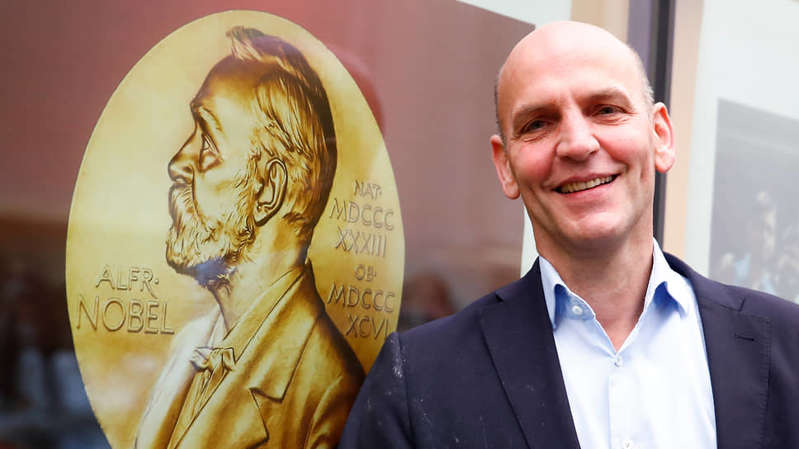
Professor of Princeton University in the USA David McMillan
Chemistry Prize awarded for asymmetric organocatalysis
The 2021 Nobel Prize in Chemistry was awarded to German and American scientists Benjamin List and David McMillan for their development of the asymmetric organocatalysis process. In addition to the existing methods of accelerating chemical reactions with the participation of metals and enzymes, the laureates discovered a third type of catalysis – with the help of amino acids and other organic substances. The Institute of Organic Chemistry of the Russian Academy of Sciences named the laureates outstanding scientists, explaining to Kommersant that their discovery is actively used in agrochemistry and pharmaceuticals, including for the production of cleaner antibiotics and other drugs without side effects.
“Chemists can create new molecules by connecting small building blocks, but it is difficult to manipulate invisible substances to bind the desired way,” – said in a press release from the Nobel Committee. The communiqué explains that such a “brilliant tool for building molecules” – organocatalysis – was created by the 53-year-old director of the German Institute for Coal Research of the Max Planck Society, Benjamin List, and his peer professor at Princeton University in the United States, David McMillan.
For the first time, the process of catalysis as an accelerator of chemical reactions was described in 1835 by the Swedish scientist Jacob Berzelius, explains on the website of the committee, which also says that now 35% of world GDP is connected with this process in industry “in one way or another”. Until 2000, two types of catalysts were known – enzymes and metals. Nobel laureates discovered a third type of catalysis. Benjamin List drew attention to the fact that metal atoms are present in a significant part of enzymes, but some of them catalyze chemical reactions without the help of metals. “Instead, the reactions are triggered by one or more individual amino acids in the enzyme,” the committee's website says. A German chemist theorized that amino acids could be made catalysts on their own by isolating them from enzyme molecules. Mr. List managed to prove this with the example of the amino acid proline.

Director of the German Institute for Coal Research Max Planck Society Benjamin List
David McMillan came up with the same idea, but from a different angle. For example, an American chemist drew attention to the fact that the developed metal-based catalysts are rarely used at large enterprises due to the high cost and complexity of use (this requires the absence of moisture and oxygen during the reaction). Then Mr. Macmillan decided to use small organic molecules (instead of an inorganic metal as a catalyst) and began “experimenting with iminium ions,” the Nobel Committee explains.
Works in 2000 were published virtually simultaneously, but the name was invented by an American scientist – organic catalysis, or organocatalysis. This type of catalysis has received the prefix “asymmetric” – as allowing to obtain the desired type of “isomers from two different molecules” in reactions, the committee's website explains. “These catalysts are harmless to nature and cheap to manufacture,” the communiqué adds.
Deputy Director of the Institute of Organic Chemistry (IOC) of the Russian Academy of Sciences Alexander Terentyev told Kommersant that he personally knows the Nobel laureates and considers them to be outstanding scientists. The discoveries of Benjamin List and David McMillan are widely used in agrochemistry (for example, in the production of pesticides) and pharmaceuticals, explains Mr. Terentyev. “Previously, chemical synthesis produced two optical isomers. Sometimes, one of them was a poison, and the other was a medicine, ”he adds. As an example, the scientist cites the history of the sleeping pill thalidomide, which was popular in the 1950s in the United States: its use by pregnant women led to the appearance of thousands of children with congenital pathologies. “At that time, they did not yet know that optical isomers have different activities and one causes a calming effect, and the second – fetal malformations. In pharmaceuticals, in general, it often happens that half a pill works, and the other half does not, and it is impossible to separate them. Thanks to the discovery of the Nobel laureates, science has actually learned to isolate the required substances, ”explains the deputy director of the Institute of Organic Chemistry, Russian Academy of Sciences. Such technologies, according to him, made it possible to make the drug levofloxacin from the antibiotic ofloxacin “without unnecessary impurities.” “You can take a pill that is half the weight without side effects,” adds Mr. Terentyev. The committee's website provides an example of strychnine, the synthesis of which with the help of organocatalysis made it possible to produce it “7 thousand times more efficiently”, as well as the antiviral drug oseltamivir.
Johan Akvist, chairman of the Nobel Committee on Chemistry, said the discovery of the laureates was “as simple as it is ingenious: many people wondered why we hadn't thought about it before.”
The Nobel Prize will be awarded on December 10 in Stockholm: the laureates will share 10 million Swedish kronor (about $ 1.1 million). Recall that in 2020, the award in chemistry went to Emmanuelle Charpentier and Jennifer Doudne, the authors of one of the most popular methods in genetic engineering, “genetic scissors” (CRISPR-Cas9).
Alexander Voronov
Read also:

